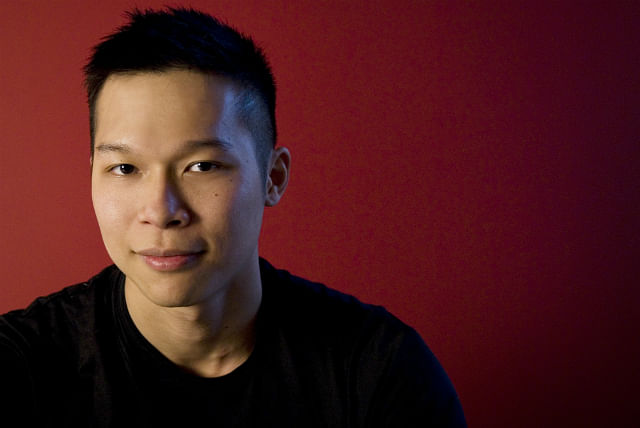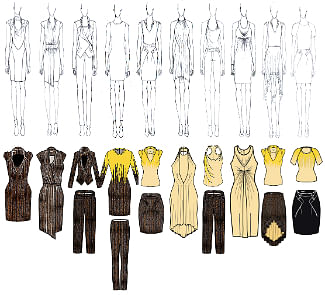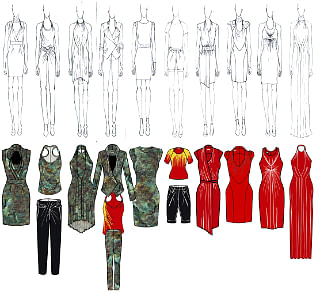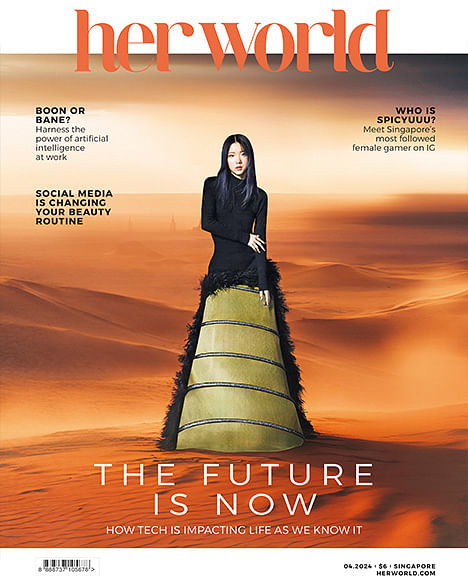Not everyone will have heard of Singapore-born London fashion designer Eugene Lin, despite the fact that he’s been producing precisely cut, elegant womenswear under his own name since 2009.

After graduating from Central Saint Martins College of Art & Design with a BA (hons) in Fashion Design Womenswear and a distinction in its Post-Graduate Pattern Cutting course, Lin worked for Roksanda Ilincic and fellow Singaporean designer Ashley Isham but he’d already honed his pattern-cutting skills while still a student at labels like Tristan Webber, Preen and Vivienne Westwood.
It is this focus on pattern-cutting ‒ something that has always been Lin’s core strength and interest ‒ that makes his work different from other emerging fashion designers. It is also the reason why his label is certain to grow in visibility.
Eugene Lin, the label, focuses on its creators very particular eye and brilliant technical skills to produce clothes that move away from seasonal “fads” to become instant classics.
The preciseness of the tailoring and a restrained use of colour that allows the lines of the garments to speak for themselves, means that a piece from Eugene Lin is clearly identifiable as high-end fashion but is not obviously “on trend”.
In his brand description, Lin says: “Sensuous yet subtle, the unique identity of each piece reflects the quiet poise of our clients, understated yet confident.”
This concept also describes Lin’s Spring Summer 2012 collection Room 101, named for both the torture chamber in the Ministry of Love in George Orwell’s Nineteen Eighty-Four and, ironically, the room for the B(A) Hons Womenswear course at Central Saint Martins College of Art and Design where Lin studied.


Illustrations from Eugene Lin Spring Summer 2012 collection, Room 101
There is a darkness in both the source of the collection’s inspiration – right down to a digital print inspired by the Drunkard’s Cloak, a 17th century wooden barrel of shame paraded by drunkards, and Iron-Maiden – and in the shades chosen for the garments; black and grey enlivened with yellow, red and the murky green of the print.
The brand’s conceptual nature is, however, simply a reflection of its creator’s innate intellectualism. Something that is startlingly clear in our interview with Lin below. This is a fashion designer who thinks; not only about how best to create a garment, but also about why he should do so.
Enjoy this insight into what makes a creative person tick, as we chat with fashion designer Eugene Lin about being Asian, whether or not that’s important, his underlying principles of design and where he hopes to be in five years time.
In my opinion, in five years time, the name Eugene Lin will be on the lips of fashion lovers around the world.
Does your Asian background inform any part of your design aesthetic? And if so, how?
I received my formal training in London and I only began noticing fashion when I was 18. Back then, Singapore had very, very few places to access high fashion, and the local scene was nothing more than a dress-making service.
Singapore has a rich culinary history and scene, which I do not believe translates into fashion. While its Peranakan (Straits-born Chinese) heritage is very colourful, the last thing I want in my work is souvenir Orientalism.
A bizarre assumption people seem to make is that just because I am of Asian descent, that the brand is automatically ‘Asian’, whatever that concept may mean to them.
I am very proud to be Singaporean, but my work has been described by buyers and press as firmly Euro-centric – combining the edgy prints London is known for with the sophistication of garment construction that Paris loves.
One does not see Alexander Wang or Philip Lim making ‘Asian’ clothes, do they?
This brings into the conversation a discourse of what Asian clothes are in this day and age … I believe my work is not bound by geography or cultural lines, as good design has an international audience.
The only thing I reckon I bring from my culture is the hard-work ethic I take in working on my collections where I still personally cut and fit each piece, while managing the many other aspects of the business.
Your work is described as “truly unique pieces that defy seasonal fads” … What differentiates your work from other designers; what is your underlying concept when it comes to creating a piece?
A Eugene Lin trademark is the creative cut and perfect fit of a Eugene Lin piece. It sounds generic and simplistic compared to ‘I only use black’ or ‘I make wacky showpieces’, but the way a designer cuts – and this extends to the careful placement of prints – is really incredibly personal and identifiable like handwriting – which is why designers who are not technically skilled always have a – sometimes professional, more often not – generic, high-street feel to their clothes, simply because some pattern cutter has interpreted their clothes, however successfully or not.
It is like an artist who communicates his vision aurally to a painter who then puts it on canvas – it will never be unique or true to the vision.
Not Eugene Lin. The level of attention I pay to cut, constant re-fitting is evident as soon as my clients put on my pieces, they can not only see it but more importantly feel the craftsmanship, which is at the heart and soul of my signature slim, elegant yet contemporary silhouettes.
Some of my cutting techniques have to do with subversion of details and shapes, which challenge perceptions of how clothes can be constructed.
At other times I combine it with careful placement of prints to create optical illusions. There is a certain sensuality (not ‘sexual’) in the way I cut my pieces that invokes a refined sophistication that the label is gaining recognition for.
When a brand has developed its handwriting over a sustained period of time, hiring pattern cutters to cut in the style of the house will be a necessity because of the heavy workload.
But I look at geniuses like the late Lee McQueen and Azzedine Alaïa who still cuts his pieces personally in awe.
Where do you source your inspiration? Do you start with the fabric first? Or a shape concept?
Each collection for me starts with researching the chosen theme/story for the season. No clothes just yet, just reading and gathering as much information, text and images related to it as possible and feeling for the spark.
My work tends to be based around texts, classic or contemporary, and I look up the original text where possible and the supporting literary commentary with it.
From there, I pick a few strong ideas which I feel I can translate into clothes, before researching previous collections, anything from the 1920’s to the present, and going through my own archives and seeing what sold well or caught press attention.
I then sketch out the key pieces of the collection, and constantly look and re-work the line up from then on all the way until the clothes get presented. It is a constant balancing act, getting the colour theme, hem lines, silhouettes to sit next to each other and editing and re-editing the line-up.
Each addition or subtraction, change of colour, length, size, changes the overall composition, and it has to sit together as a whole, yet be individual enough so that buyers can buy into it as a capsule collection for their stores.
It has to push the boundaries enough to further my own work, yet hold the signature cut and aesthetic the line is known for.
While all of that is going on, it is a brutal slog of just pattern cutting, sewing the toiles, fitting, re-fitting and repeating the process over and over until the garment is perfect, while juggling ordering of fabrics, production time lines etc.
For people who do not appreciate the technicality of a designer cut, they would not understand the incredible amount of effort it takes to create a collection of international standard.
Do you see Asia as an increasingly influential market for fashion? If yes, why? If no, why not?
This is a loaded question heavier than I have time to discuss and believe me, I could write a thesis on this. As a consuming market, Asia has, without a doubt, out-performed the rest of the world in terms of consuming fashion – both high-street and high-fashion.
As a producer, and by this I mean Asian design talent being an influence on the domestic and international scene? No. Definitely not yet (I stress the use of the word ‘yet’).
There is a laughable myth that just because Asia is consuming on the aforementioned grand scale, that somehow Asian designers are benefiting from it.
One need only look at the sales figures and trends to see that the top 10 labels are all European and American.
Big labels like Alexander Wang, Philip Lim, Thakoon, Jason Wu and Jimmy Choo may be headed by Asians, but they are not Asian-based brands and are clearly aimed at the international market.
In my recent visit to Singapore in December 2011, I noticed how little support and interest there was for real Asian born-bred-and-based labels were: practically zero.
Whereas people were flocking to the latest high-street multi-national company which had just opened its doors in the droves. Asia is still very sadly, and bluntly, a blind consumer by and large.
However, things are starting to take a slow shift. I see Asia-oriented brands like Shang Xia gaining prominence in both domestic and international circles, and mainland Chinese designers like Qi Gang starting to get serious attention at Hong Kong Fashion Week.
That is because the elite rich Chinese are slowly maturing past their need for ostentatious consumption of Western status symbols into intelligent consumers of high-fashion. They are beginning to appreciate the Asian aesthetics they grew up with and learning to mix them with pieces from international labels, so this is encouraging, but still such a small percentage.
The danger is this: how long can Asian designers hang on, hand-to-mouth, before Asia matures and starts appreciating its own talent? Or do Asians have to continue making their mark in the West before they are recognised as being ‘influential’?
Where would you like to see your brand in 5 years time?
I would like to be presenting seasonally in an intimate presentation format or catwalk, and have a larger number of stockists internationally.
An exclusive but limited range of Eugene Lin is available from www.thenandnowshop.com/eugene-lin, otherwise the label is only available via private order. You can contact the designer via email at sales@eugene-lin.com. Go to www.eugene-lin.com to see more examples of the brand’s Spring Summer 2012 collection, Room 101.


